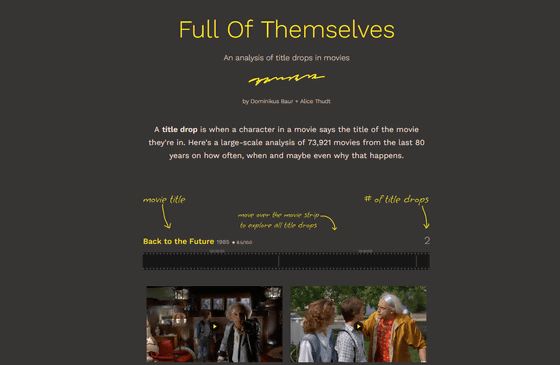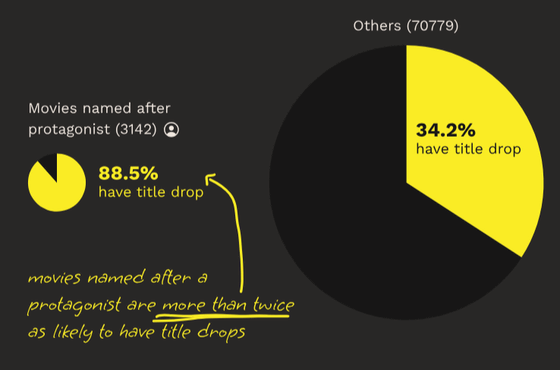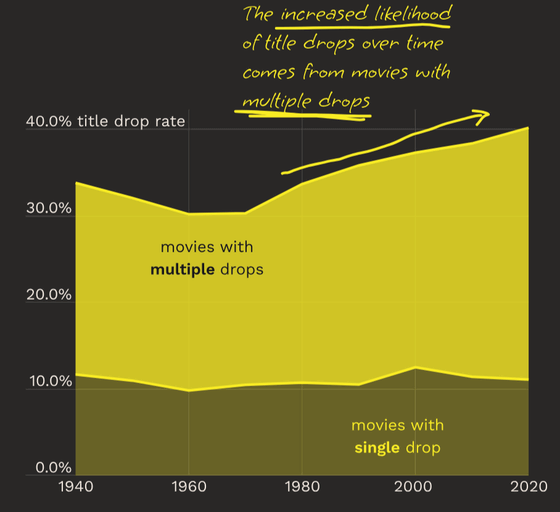In what percentage of movies does a character 'recover the title'?

Full of Themselves: An analysis of title drops in movies
https://www.titledrops.net/

Title salvation is a line that includes the title of a work, and has a strong effect of becoming a symbolic line in the work or making the viewer aware of an unexpected purpose contained in the title. According to Baur, the oldest example of title salvation dates back to 1911, when the first feature film was released in Serbia and the Vatican Peninsula, ' Karađorđe .' Since then, coupled with the fact that it has become established as a technique, title salvation has become more common up to the present day, and it is believed that the number of works using title salvation has increased significantly.
Regarding how many movies have title recovery, there are 'lists of works with impressive title recovery scenes' and data that has been compiled and analyzed for many movies in the past, and it has often been noted, but the past analysis data was for about 1,200 movies, which was hard to say comprehensive. Therefore, Baur conducted a detailed analysis of title recovery on 73,921 movies from 1940 to 2023 that have at least 100 user votes on IMDb, an online database that collects information related to streaming content. According to Baur, this corresponds to about 60% of all movies, and it can be said to be the first detailed analysis of title recovery.

The analysis began by combining metadata for 121,797 films from IMDb with 89,242 English subtitles from
With the completed dataset, the number of title recalls can be measured by analyzing whether the title is included in the subtitles, but here we encountered a problem. For example, in the case of a distinctive title like ' Back to the Future, ' it is easy to identify the scene where Doc tells Marty, 'Let's go back to the future.' However, for example, 'It ,' the original title of 'IT,' is a commonly used word, so it appears many times in the film. Also, in 'Back to the Future,' in the memorable scene in the second film in the series where Marty tells Doc, 'Let's go back to the future,' he never utters the line that is the title, ' Back to the Future Part 2 ,' so a simple mechanical analysis is difficult.

Baur applied several rules to match lines and titles, including ignoring 'A' or 'The' at the beginning of the title, omitting the sequel number or 'Episode' or 'Part,' and splitting a title into '
As a result, of the 73,921 films analyzed, 36.5% (26,985 films) contained at least one title recovery. The total number of title recovery counts was 277,668, which means that each film with a title recovery had an average of 10.3 title recovery attempts.
When the title of a work is the name of a character, the title return occurs every time that character's name is mentioned, so the number of times naturally increases. According to the analysis, works in which a character is the title have an average of 24.7 title return occurrences, which is more than twice as many as other titles. In addition, 36.5% of works included at least one title return, but the title return rate for films named after the main character was 88.5%, and if those types of films were excluded, the title return rate dropped to 34.2%.

The movie with the most title returns was ' Barbie ,' released in 2023, which has a total of 267 title returns during its 1 hour and 54 minute running time. In addition, the documentary film ' Mickey Mouse: The Story ' has the word 'Mickey' uttered 309 times in 90 minutes, which means Mickey appears 3.43 times per minute.
According to Baur's analysis, the top five films with the most title salvations are as follows: The image below the title shows the width of the film, which indicates the length of the film, and the white vertical lines in the film are the scenes where the title is salvaged.
・Mickey Mouse: The Story



・

・

Based on the above analysis, it is possible to argue that the repeated use of the title in dialogue is often not intentional, and that the use of the title at a critical moment is what constitutes a title payback. Baur then recounted the number of films that had a single title payback, and found that 11.3% of all films had this. Baur said, 'Films with multiple title paybacks are only about twice as common as those with only one title payback. In the case of a single title payback, it is highly likely that the filmmaker intended to do so consciously, and this percentage was surprisingly high.'
Below is a graph showing the number of films with title salvage by decade. From the 1940s to the 1970s, there was a downward trend, but from then on there was an upward trend until the 2020s, when it accounted for more than 40% of the total.

The graph below shows the percentage of titles salvaged by decade, divided into those with multiple title salvage and those with a single title salvage. The light yellow at the bottom of the graph are films with a single title salvage, and the percentage has not changed much from the 1940s to the 2020s. On the other hand, the percentage of films with multiple title salvage has increased significantly since the 1970s. Baur suggests that the reasons for this may be that more films are named after the main character, or that films have focused on box office success over artistic quality, leading to titles being repeated throughout the film to gain brand recognition.

Baur then conducted an additional analysis to see whether a large number of title recalls would affect a film's reputation. In cases where a film's title is forcibly repeated in order to gain brand recognition, the film's rating may be lowered because it makes viewers feel uncomfortable. However, the title recall rate is almost constant from low to high ratings on IMDb, and it turns out that there is almost no correlation between title recalls and film ratings.
Finally, there is a negative correlation between the title recovery rate of a movie and the length of the title. Baur's analysis was conducted on American titles and English subtitles, but since there are trends in whether movie titles tend to be simple words or unique words or sentences depending on the country, the title recovery rate may vary depending on the country and language analyzed. As an example of a title recovery despite its long title, Baur cites 'That Time I Got

At the bottom of Baur's site, you can search for the title of a movie to see if it has a title recovery. Click on the search box and enter the English title of the movie.

Search for '

The analysis result for the title recovery in 'Your Name' was '0.' In this way, it is possible to search for the number of title recovery from works in the database, although it is only the lines in the English translation that match the English title.

Related Posts:
in Movie, Posted by log1e_dh






